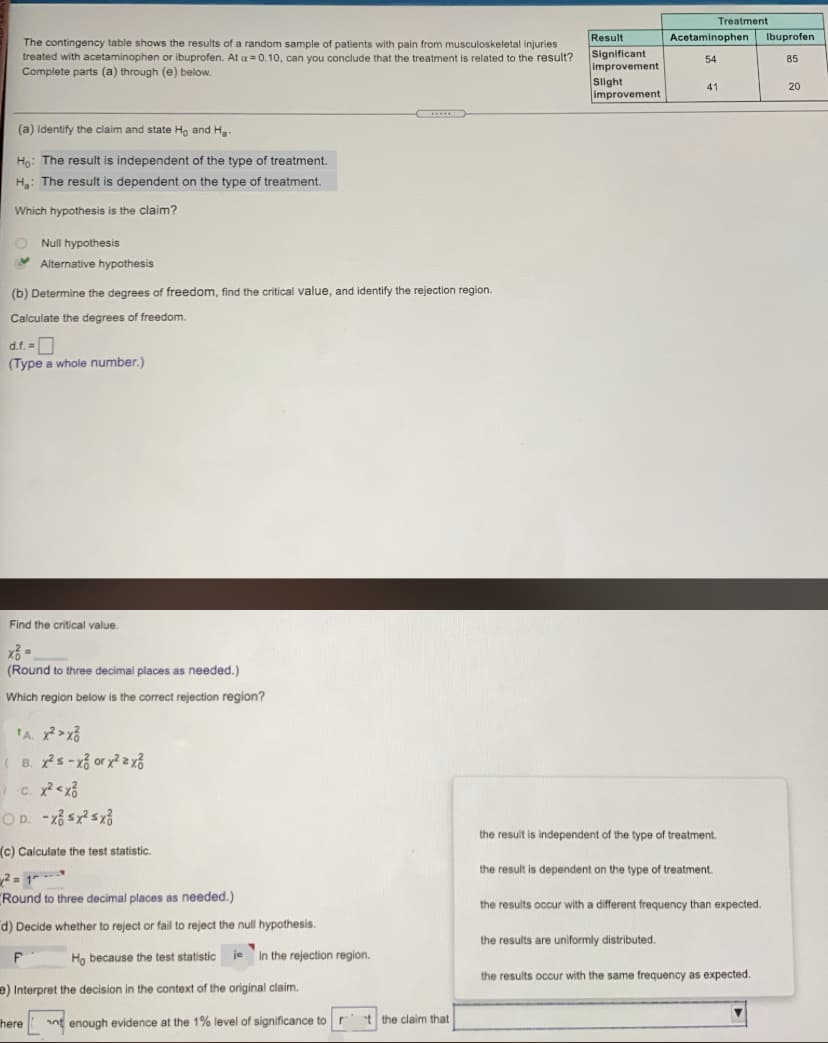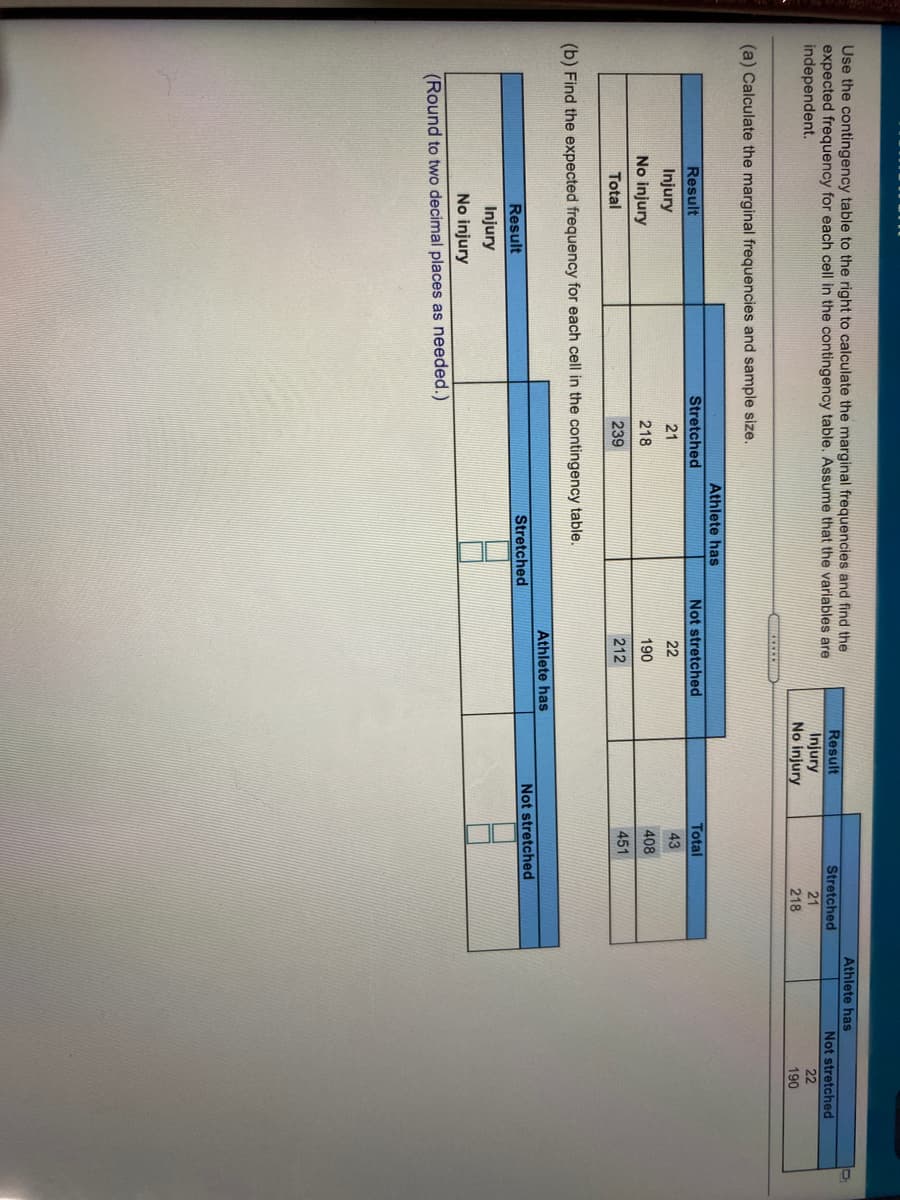The contingency table shows the results of a random sample of patients with pain from musculoskeletal injuries treated with acetaminophen or ibuprofen. At a = 0.10, can you conclude that the treatment is related to the result? Complete parts (a) through (e) below. (a) Identify the claim and state Ho and Ha. Ho: The result is independent of the type of treatment. H₂: The result is dependent on the type of treatment. Which hypothesis is the claim? 1 (b) Determine the degrees of freedom, find the critical value, and identify the rejection region. Calculate the degrees of freedom. Null hypothesis Alternative hypothesis d.f. - (Type a whole number.) Find the critical value. x3 = (Round to three decimal places as needed.) Which region below is the correct rejection region? TA. x² >x² (B. x²s-x orx²2x² c. x² < x² OD. -x5x²5x² (c) Calculate the test statistic. ²1- Round to three decimal places as needed.) d) Decide whether reject or fail to reject the null hypothesis. Ho because the test statistic e) Interpret the decision in the context of the original claim. F here je In the rejection region. nt enough evidence at the 1% level of significance to r t the claim that Result Significant improvement Slight improvement Acetaminophen Ibuprofen 85 54 41 the result is independent of the type of treatment. the results are uniformly distributed. the result is dependent on the type of treatment. Treatment the results occur with a different frequency than expected. the results occur with the same frequency as expected. 20
The contingency table shows the results of a random sample of patients with pain from musculoskeletal injuries treated with acetaminophen or ibuprofen. At a = 0.10, can you conclude that the treatment is related to the result? Complete parts (a) through (e) below. (a) Identify the claim and state Ho and Ha. Ho: The result is independent of the type of treatment. H₂: The result is dependent on the type of treatment. Which hypothesis is the claim? 1 (b) Determine the degrees of freedom, find the critical value, and identify the rejection region. Calculate the degrees of freedom. Null hypothesis Alternative hypothesis d.f. - (Type a whole number.) Find the critical value. x3 = (Round to three decimal places as needed.) Which region below is the correct rejection region? TA. x² >x² (B. x²s-x orx²2x² c. x² < x² OD. -x5x²5x² (c) Calculate the test statistic. ²1- Round to three decimal places as needed.) d) Decide whether reject or fail to reject the null hypothesis. Ho because the test statistic e) Interpret the decision in the context of the original claim. F here je In the rejection region. nt enough evidence at the 1% level of significance to r t the claim that Result Significant improvement Slight improvement Acetaminophen Ibuprofen 85 54 41 the result is independent of the type of treatment. the results are uniformly distributed. the result is dependent on the type of treatment. Treatment the results occur with a different frequency than expected. the results occur with the same frequency as expected. 20
A First Course in Probability (10th Edition)
10th Edition
ISBN:9780134753119
Author:Sheldon Ross
Publisher:Sheldon Ross
Chapter1: Combinatorial Analysis
Section: Chapter Questions
Problem 1.1P: a. How many different 7-place license plates are possible if the first 2 places are for letters and...
Related questions
Question
3 Complete it please 5

Transcribed Image Text:Treatment
Result
Acetaminophen
Ibuprofen
The contingency table shows the results of a random sample of patients with pain from musculoskeletal injuries
treated with acetaminophen or ibuprofen. At a = 0.10, can you conclude that the treatment is related to the result?
Complete parts (a) through (e) below.
Significant
improvement
54
85
Slight
improvement
41
20
....
(a) Identify the claim and state Ho and Ha
Họ: The result is independent of the type of treatment.
H: The result is dependent on the type of treatment.
Which hypothesis is the claim?
O Null hypothesis
Y Alternative hypothesis
(b) Determine the degrees of freedom, find the critical value, and identify the rejection region.
Calculate the degrees of freedom.
d.f. -0
(Type a whole number.)
Find the critical value.
(Round to three decimal places as needed.)
Which region below is the correct rejection region?
( B. xs-x3 or y2zx3
OD. -xổ sx? sx3
the result is independent of the type of treatment.
(c) Calculate the test statistic.
the result is dependent on the type of treatment.
2 = 1- --
"Round to three decimal places as needed.)
the results occur with a different frequency than expected.
d) Decide whether to reject or fail to reject the null hypothesis.
the results are uniformly distributed.
Họ because the test statistic je in the rejection region.
the results occur with the same frequency as expected.
e) Interpret the decision in the context of the original claim.
here
nt enough evidence at the 1% level of significance tor
t the claim that

Transcribed Image Text:Use the contingency table to the right to calculate the marginal frequencies and find the
expected frequency for each cell in the contingency table. Assume that the variables are
independent.
Athlete has
Result
Injury
No injury
Stretched
21
Not stretched
22
218
190
(a) Calculate the marginal frequencies and sample size.
Athlete has
Result
Stretched
Not stretched
Total
Injury
21
22
43
No injury
218
190
408
Total
239
212
451
(b) Find the expected frequency for each cell in the contingency table.
Athlete has
Not stretched
Result
Stretched
Injury
No injury
(Round to two decimal places as needed.)
Expert Solution
This question has been solved!
Explore an expertly crafted, step-by-step solution for a thorough understanding of key concepts.
This is a popular solution!
Step 1: Write the given information
VIEWStep 2: Identify the claim and state the null and alternate hypotheses
VIEWStep 3: Determine the degrees of freedom, find the critical value, and identify the rejection region
VIEWStep 4: Calculate the test statistic and decide whether to reject or fail to reject the null hypothesis
VIEWSolution
VIEWTrending now
This is a popular solution!
Step by step
Solved in 5 steps with 22 images

Knowledge Booster
Learn more about
Need a deep-dive on the concept behind this application? Look no further. Learn more about this topic, probability and related others by exploring similar questions and additional content below.Recommended textbooks for you

A First Course in Probability (10th Edition)
Probability
ISBN:
9780134753119
Author:
Sheldon Ross
Publisher:
PEARSON


A First Course in Probability (10th Edition)
Probability
ISBN:
9780134753119
Author:
Sheldon Ross
Publisher:
PEARSON
